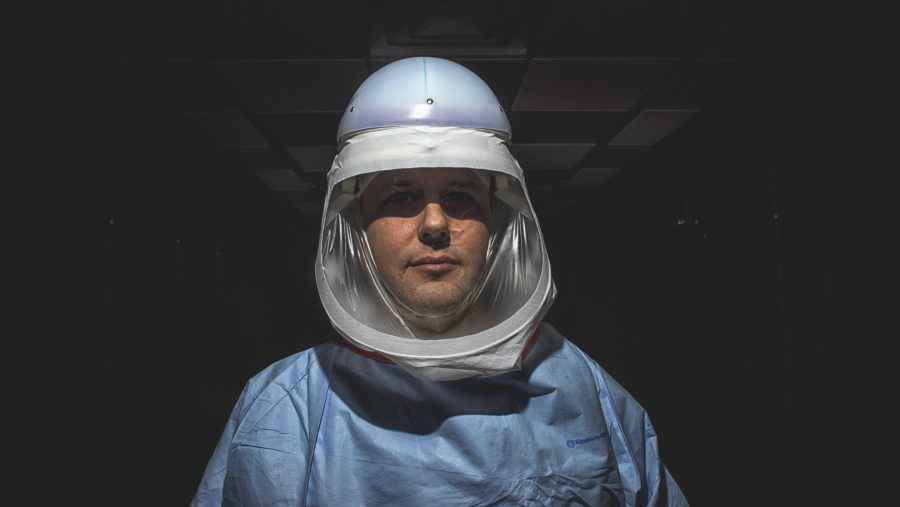The University of Iowa Hospitals and Clinics has teamed up with the Nebraska Biocontainment Unit to add an extra layer of protection to both their employees and the Midwest.
Members of the media, including me, took off our press passes and scrubbed in for a mock pandemic situation. The helmet protecting my face was heavy and tight, the built-in fans made wearing it more bearable. We wore three layers of gloves, which made my fingers basically immobile. The practiced nurses didn’t seem to have that problem and could go about their tasks in the Special Isolation Unit with relative ease.
UIHC volunteers and I trained on Tuesday to work in the UIHC’s Special Isolation Unit. This unit was created in December 2014, during the Ebola outbreak.
At the time, there were only 13 hospitals in the country that were equipped to care for Ebola patients safely, and Nebraska Medicine was one of them.
Kate Boulter, a member of the Nebraska Biocontainment Unit Leadership Team, has successfully treated Ebola patients and made the unit the safest it can be for both the patient and the staff. She came here to help the university do the same.
The training started out with a lecture by Boulter about special pathogens and what the Nebraska unit has learned over the years of treating different diseases. She noted that one of the most important things a team needs in a high-risk unit like this is trust and teamwork.
“It’s not always about the clinical work … your staff are already going to be highly skilled at what they do because they work in different departments …” Boulter said. “You’re not teaching them how to do their job, you’re teaching them how to do their job in the biocontainment unit and how to work with each other.”
Nebraska Medicine and UIHC are the only treatment centers of this kind in the region, which includes Nebraska, Kansas, Missouri, and Iowa.
This makes these two hospitals the first line of defense against a possible pandemic, Mary Beth Kukla, a UIHC infection preventionist said.
“In a way, it is in case of emergency, but it’s not just for people who walk through our doors … generally, we would have a couple of days to set thing up and get everyone up to speed,” UI Clinical Associate Professor Jonathan Simmons said.
The team members have normal jobs in the hospital, but if an infected individual is scheduled to come in, they get a quick debriefing and refresher on protocol in the unit.
After the lecture, we all practiced “donning and doffing,” or getting into and out of Personal Protective Equipment. Some of these clothes, such as shoe covers and gowns, are used regularly in the hospital, but the Special Isolation Unit requires extra protection from contamination.
The temperature of the hospital was tightly controlled, never too hot or too cold. With the gown on, though, I could see staff getting uncomfortably warm as hours rolled on.
Every hallway smelled of antiseptic with just a hint of coffee; the smell made me feel both safe and uncomfortable.
In order to stay safe, I put on two layers of shoe covers, three layers of gloves with tape connecting them to my sleeves, a gown, apron, and smock, and a helmet with a visor to completely shield my face, head, and neck.
The doffing process was fairly daunting.
There are 53 steps to completely disrobing and sanitizing after being with a patient, nine of those directing us to do hand hygiene with alcohol gel, either on our gloves or hands. The process starts in the patient’s room and slowly migrates out the door and into the anteroom, where another staff member waits to help with the rest.
All of these steps are necessary to stopping the spread of a pathogen through health care staff, which has been a major problem in the past, Boulter said. Even the waste has to be sanitized before being disposed of.
While all the sanitation may seem like overkill, UIHC and the Nebraska unit both insist that it’s the best way to keep everyone safe.
“We feel that we should protect our community, our patients, and our staff from any emerging infectious diseases,” Kukla said.



